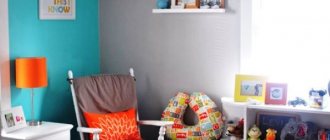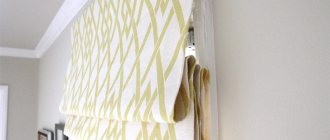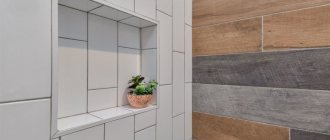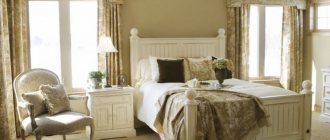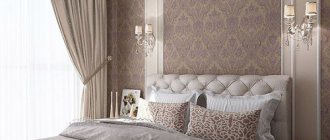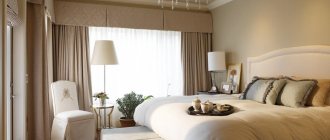Experiments in creating original wall decoration have no limits. Imitation of stone or brickwork, textured plaster and other techniques are certainly very unusual, but, alas, not everyone can afford it. In addition, such techniques often require professional skills and abilities in application to the surface. However, you can always find an alternative, and in this case it is companion wallpaper. What they are and how to use them in the interior - more on that later.
What is companion wallpaper?
Companion wallpapers are two canvases that are different in color or texture, but are in harmony with each other. This method of finishing has a lot of advantages; it allows you to make the room more voluminous, hide imperfections in area or lighting, and also gives the interior individuality.
A little about accents
There should be one accent wall. Making two surfaces in one room at once in the “Cuba” or “London” style risks creating the impression of bad taste and bad manners.
Neutral light wallpaper is good for small rooms, or living rooms with several doors and window openings. A rectangular bedroom or children's room will look great in a dark design, especially if the room is located on the sunny side of the house.
- Designers recommend purchasing accent black, gray and white wallpaper with silver splashes in the “Cuba” style and matching it with dark gray, rich rolls of matting.
- Another option, “Night London” in rather rich gray shades and light gray wallpaper as a background.
- Neutral wallpapers look great in combination with urban or natural motifs and landscapes, where there are bright accents.
- Drawings in red, orange tones, or golden, warm ocher inclusions.
- Accent abstraction is also welcome, which will look great in combination with a pastel background.
As a rule, an accent wall should not be overloaded with decor. The maximum that can be hung on it is a large flat plasma TV. Paintings, photo frames and other decor on the wall, where there is a full-fledged picture of a night city or Venetian motifs, are not appropriate.
The accent wall should be chosen based on the principle of clarity. This means that it should be placed in a prominent place, one that catches the eye when entering the room.
Rules for selecting companions
When choosing wallpaper companions, you should adhere to one rule. Two seemingly different types of wallpaper must be connected by something so that they look like one whole in the picture of the room. This could be texture, color scheme or pattern. It is also preferable to choose companion materials of the same thickness and manufacturer; construction stores often display different variations of wallpaper combinations on one stand, this greatly simplifies the task.
One color scheme - different pattern or texture
It is not necessary to select identical colors; similar shades of the same color, but different tones, can connect different types of companion paintings. For example, one canvas is a plain purple color with a relief texture, another with a smooth surface and a three-dimensional pattern in the form of purple flowers on a light background.
In the photo, the walls in the bedroom are decorated in the same color scheme with companion non-woven wallpaper. The coatings differ in pattern and texture.
This method of combining companion wallpaper will add volume to the room and make it visually larger.
Same texture – different pattern or color
A common texture can unite wallpaper companions; a pronounced relief will be noticeable in any color design. The selection of colors can be contrasting, for example black and white, or a softer combination.
The photo shows a spacious studio apartment. Finishing with companion wallpaper with different patterns visually divides the space into zones.
The same texture of the companions' wallpaper will imperceptibly connect different patterns; even on completely different images the same relief will be visible.
Same pattern - different texture or color
The overall pattern will combine two companion wallpapers. The image can be the same, but have a different size, for example, on one surface there is a pattern with large monograms, on the other they are the same, but smaller in size.
The photo shows a children's room for a girl. Wallpaper companions have different colors, but are united by theme. There are castles on both walls.
The same pattern can combine completely different colors and textures; companion wallpapers can be smooth and embossed, contrasting and calm combinations.
Different colors, textures and patterns
The most difficult design option will be a combination of completely different types of companion wallpaper, with different textures, colors and patterns. This method of companion wallpaper should be selected with care, otherwise you can end up with a tasteless interior.
The main rule is that even completely different surfaces should be in harmony with each other. The colors can be different, but at the same time be combined, for example, be pastel shades. The drawing should not be similar, but have a common theme, such as a plant one.
Combining photo wallpaper with wallpaper
The combination of wallpaper with photo wallpaper deserves special attention. I noticed that, at first glance, things are a little better with them, at least the choice of wall is almost always successful. But there are still some nuances.
Example No. 19
I like the choice for an accent wall: the correct location at the end of the room, near the bed, in the room there is enough distance to appreciate the image as a whole, and not look at it point-blank. I like the large size, wall to wall, joints in the corners. It's all wonderful and well done. But the very combination of photo wallpaper and pattern on the remaining walls looks bad. It would be much better if the second wallpaper was paintable or smooth, plain white or sand color.
Badly
Example No. 20
Exactly the same story. The right accent wall, the right size, but completely incompatible with the main wallpaper. Moreover, the main ones are also quite interesting and not bad in themselves. They just shouldn't be together. Here we need plain ones.
Badly
Example No. 21
Should I comment anything on this photo? It seems to me that you can see everything yourself: the collision of photo wallpaper on the adjacent wall (what prevented you from trimming???), the combination with striped ones (you need plain ones), and a closet that “allows you to enjoy” the views of the city at night.
Everything is very bad
By and large, to summarize, we can distinguish 3 main mistakes:
- lack of idea and meaning in combining wallpaper, acting like a fool;
- wrong choice of accent wall;
- the use of wallpaper does not cover the entire area of the wall, the joints are not in the corners.
From here follow 5 simple rules, and if you take them into account, I think that you can easily combine beautiful wallpaper in your room. Learn from other people's mistakes, not your own!
- Accent wallpaper is placed on the view wall, there must be good viewing points, the minimum distance from the viewing point is 3-4 meters, or better yet more.
- Never use any ready-made companions if they both have an active pattern.
- The best combination for photo wallpapers and others with an active dynamic pattern is plain wallpaper.
- Glue accent wallpaper on the entire wall, from corner to corner or other architectural elements (edges of a niche, ledge, etc.), then you don’t have to think about how to design the joint.
- Think about why you want to draw the attention of those present to this wall, think over the idea.
Examples of combinations in the interior of rooms
For the hall (living room)
The living room has more interior design options than other rooms in the house. Unlike a bedroom or kitchen, a combination of companion wallpaper in bright colors and with voluminous patterns that can be united by a common theme would be appropriate in the living room.
With the help of companion wallpaper, you can highlight any area, for example, a relaxation area near the sofa and armchairs or a cozy place for reading. In addition, companion wallpaper will be a good interior solution for a living room combined with a kitchen; this method of finishing will help to designate zones, visually separating them.
For the bedroom
Companion wallpaper is a common design solution for bedrooms. This method of finishing can be used to designate a sleeping or lounge area, as well as visually enlarge the space.
The photo shows a marine-style bedroom. Companion wallpaper, like other items, has a pattern with a common theme.
With bright, contrasting companion wallpaper, you can decorate the wall above the head of the bed, thereby highlighting and decorating it.
For kitchen
Companion wallpaper will help divide the kitchen into a work area and a dining area.
Bright wallpaper can be used to decorate the entire wall of the dining area or just the part directly above the dining table. The wall above the work area can also be an accent wall. Wallpaper should be protected with transparent glass above the cooking area.
For the hallway
In Khrushchev-era and standard city apartments, the hallways are not very large; paired wallpaper companions will make this room more interesting and voluminous.
It would be more appropriate to use companion wallpaper with a light color palette; different patterns and textures will diversify a small space, and light colors will preserve the area.
For children's
Companion wallpaper is an excellent solution for a child’s room; original combinations will make the child’s room more interesting and fun. A boy's room can be decorated in a light blue tone, combined with yellow or white motifs.
For girls, wallpaper companions in delicate colors are suitable: pink, lilac, yellow. For a child’s nursery, it is better to choose a calm palette; you can decorate a teenager’s room in bolder shades.
The photo shows a children's room for a girl in the attic. The decoration is made with companion wallpaper in a light palette with pink accents.
A game of contrasts for combining wallpapers
You can combine quite contrasting shades, one of which is bright, the other pastel.
Designers advise combining the following colors:
- Black White.
- Beige - red.
- Brown – cream or vanilla.
- Olive - ocher or sand.
- Lilac – dark purple or gray.
By the way, all colors without exception are combined with a gray tone. Plain gray will “make friends” with bright red, yellow, orange, rich pink and even turquoise or blue.
Color combination ideas
Beige
The calm, universal tone goes well with a variety of colors. Beige harmonizes with bright and calm, warm and cold colors. It also successfully serves as a background. The best combinations will be with wallpaper companions in white, blue, emerald, red, brown and black. Depending on the partner’s color choice, companion wallpaper will look good in the interior of any room.
White
The white tone is harmonious with any colors. The combination can be soft or contrasting, the colors rich or pastel. A combination of white and blue, red or black will look especially good. Also, the texture is clearly visible on a white background.
Gray
The gray color of the wallpaper is harmonious with clean and dusty shades. Cold and warm gray tones are suitable for interior design in a modern style. The combination with pink and purple colors will look soft and gentle. Wallpaper companions of blue, red and fuchsia are a more contrasting, but no less successful combination.
Greens
The green tone of the companion wallpaper will look good with warm natural shades, such as brown, gray, orange, cream, gold and black. Eco themes will make the interior warm and the atmosphere soothing.
Black and white
The combination of black and white already looks complete and complete, they complement each other. However, yellow, light green, orange and purple shades can be an excellent companion to black.
Purple
The beautiful purple color will go well with gray, lilac, olive and white. Purple is suitable for interior design in a modern style. A rich shade is best used as a secondary shade.
Brown
Warm chocolate shade harmonizes with blue, turquoise, green and pink. Rich colors will stand out against a brown background. The combination with companion wallpaper in cream and beige shades is suitable for decorating an interior in a classic style.
The photo shows a loft-style living room. The walls are decorated with different types of companion wallpaper, some of them with imitation brickwork, others with plaster.
Pink
Pink color can be a delicate pastel shade or a rich fuchsia color. The light version of pink is combined with turquoise, light blue, mint, white, gray, olive and brown. For a fuchsia tone, the company will be accompanied by wallpaper companions of mustard, gray, and light green colors.
Blue
Companion wallpapers in white, grey, pink and yellow go well with a delicate blue tint. Among the bright colors to combine, red, orange, and brown are suitable. Depending on the partner color, the interior will be bright and rich or calm.
Golden
Golden accents will decorate the wallpaper with companion colors of turquoise, peach and gray. Gold looks impressive with companion canvases in brown, red and black tones.
Yellow
Sunny yellow combines well with cool shade companions: blue, blue, gray, black and lilac. Yellow color will add sun to the interior of the room.
Lilac
The lilac shade can be combined with companion wallpapers of cream, light yellow, pink, light turquoise and black. The shade creates a delicate combination even with dark colors.
Turquoise
Refreshing turquoise will be a good companion to brown, black, dark pink, beige, white and yellow. A good addition would be golden or silver elements.
Same texture – different pattern or color
A fashionable and popular trend is the use of wallpaper for painting. This is the best option for renovating a living room of any size. When choosing finishing materials, it is important to take into account the surface topography, since the walls can be repainted several times, but it will not be possible to change the texture. Wallpaper with a chaotic pattern is perceived pleasantly if the relief is shallow and rounded lines predominate. A simple and repeating pattern will give the decor a laconic character. The size of the relief also matters. Large drawings decorate the walls of the hall and attract attention. And a small pattern is quite capable of becoming a background for exquisite furniture. Textures that imitate untreated surfaces (brickwork, plaster, concrete) are recommended to be selected for specific styles (loft, Provence).
An excellent design technique that allows you to add dynamics to the atmosphere is to paint the walls in different shades. Thanks to this method, you can visually make the room larger or smaller. This is also a suitable option for designating zones for different purposes in the living room. In a studio apartment, pastel warm shades will bring peace to the relaxation area, and bright colors will add energy to the work area. Pleasant shades (orange, pistachio) will visually make the kitchen area appetizing and fresh.
Examples of design and pattern combinations
With flowers
The combination with a floral print is relevant for a classic, Provence or modern interior. The combination can be with plain wallpaper companions or with coverings with a different pattern. The color scheme for companion wallpaper should be chosen based on the shade of the floral pattern and its background.
The flower pattern is combined with smooth, plain surfaces, textured or striped wallpaper. A good finishing option would be to highlight an accent wall with companion wallpaper with flowers. For example, a three-dimensional image of roses above the head of the bed or sakura flowers above the seating area in the living room.
The photo shows a bedroom in neoclassical style. The walls are decorated with companion wallpaper in a horizontal manner.
Strip
Striped companion wallpaper can be combined with other images, patterns or textured surfaces. In addition to aesthetic pleasure, the strip visually adjusts the space of the room; depending on its direction, the room appears wider or higher.
When combined with voluminous images, companion wallpaper with stripes should choose a calm color palette that will echo the color of the picture. In combination with textured or non-patterned wallpaper, you can choose a bolder shade. In this case, companion wallpaper with a striped pattern will attract the main attention.
Under plaster
Companion wallpaper under plaster attracts attention due to its texture. The embossed surface looks harmonious with almost any type of companion wallpaper; patterns and ornaments, stripes, as well as 3D images would be appropriate.
Plaster coating in company with other wallpaper companions plays a secondary role.
One color scheme - different pattern or texture
This method of decorating a living room can be considered the simplest. However, before choosing wallpaper companions for the room, you have to take into account the style of the interior:
- canvases that imitate rough, untreated surfaces fit organically into modern interiors. Living rooms with an industrial touch are characterized by concrete walls, raw plaster, and brickwork. Surface shades can be different (for example, gray concrete, brown or terracotta brick, gray-beige plaster). In the Provence living room, the rural mood is emphasized by wallpaper imitating white brick or snow-white plaster;
- a fascinating play of designs and patterns can make the interior light and original. The easiest way is to combine patterns/ornaments and stripes.
A win-win option is to choose canvases in which the flowers are not arranged chaotically, but in orderly rows. The combination of striped canvases and wallpaper with geometric figures is perceived calmly and easily in a minimalist, high-tech environment.
The use of plain materials with a jacquard effect (contrast of matte and shiny textures) is a favorite technique of designers when decorating classic-style interiors.
Tips from the designer
There are a few little tricks that can help keep your room design balanced and harmonious.
- To make your design with companion wallpaper look like a single picture, you should choose a material of the same thickness and price segment. This will simplify the finishing work and will look neater. It is most convenient to choose wallpaper companions from one manufacturer.
- It is necessary to take into account color compatibility when choosing wallpaper companions. The combination can be soft or contrasting, but the colors must be combined with each other.
- The same goes for patterns. In the interior of one room, you should adhere to the same style and theme.
- When decorating the interior using the horizontal method, a larger pattern and a dark shade should be pasted in the lower part, respectively, a small pattern and a light color in the upper part.
Selecting wallpaper in different styles
Provence and country - wallpaper with small flowers or other floral patterns can be combined with a smooth texture that imitates whitewash, brickwork, and natural wood. The same techniques are used in vintage and retro styles.
Wallpaper with a floral print in a kitchen in Provence style
Avant-garde and futurism are extravagant styles for bold experiments, where everything is possible, but within reason, designers are guided by the basic rules, allowing exceptions. Floral prints in a graphic design, abstraction with recognizable elements, unusual neon shades - a white background is ideal for them.
Oriental style is characterized by an abundance of colored textiles and intricate patterns with complex weave geometry. An insert imitating expensive fabrics with oriental patterns or real textile wallpaper will look interesting.
Kitsch is a playful eclectic style born on the verge of mockery of classical traditions. This is the only case when you can balance on the verge of bad taste and experiment with the incompatible, including ways to decorate walls in the patchwork style (patchwork technique).
Unconventional and spectacular kitsch style
Classics will never go out of fashion; they will always be relevant, thanks to centuries-old verified canons of beauty. One of them is symmetry, take this into account when choosing wallpaper for inserts.
Typical wallpaper combination for European classic style
Minimalism - designers claim that everyone is returning to it from lush decoration in the Rococo style and “boring” classical forms. Refusal of everything unnecessary is an ode to asceticism, which has several varieties; modern, Japanese and Scandinavian minimalism are the most striking examples of incarnations. Provides for a combination of no more than two different textures in wall decoration.
High-tech and loft are the most popular modern styles, where inserts in the form of bare brickwork or concrete walls, metallic wallpaper and photo wallpaper on an urban theme are welcome.
Combination of horizontal and vertical stripes in a high-tech style hallway
Wallpaper was not used in historical styles, but today there are many proposals that imitate the coverings of palaces, temples and medieval castles. Baroque and Rococo - use wallpaper with monograms and imitation modeling. Frames, cornices, and classical architectural elements are appropriate, including in the wallpaper.
Wallpaper with embossed patterns in Rococo style
The majestic Empire style is an imitation of imperial luxury based on Egyptian themes; the style originated after the campaigns of Napoleon. It still reflects epic frescoes, graceful patterns and delightful exoticism. It is difficult to make the right choice of wallpaper companions in a residential interior. It is advisable to focus on special notes in catalogs and finished works of professional designers.
Remember that in a spacious room you can give free rein to bold experiments; in a small room it is better to avoid large patterns and sharp contrasts that split up the space. More interesting variations are in our photo gallery.
See alsoHow to choose wallpaper for the hallway and corridor photo ideas for an apartment
How to glue companion wallpaper?
Pasting wallpaper companions is carried out according to the same principle as others, with the exception of several factors.
- Before starting work, you need to decide on the location of the canvases.
- When designing a strip horizontally, the companions can alternate through one, frame the wall along the edges, or have a different order. For this type of finishing, it is important that the canvases have equal thickness.
- Afterwards you need to prepare the surface. To do this, you need to clean the wall from the old coating, plaster it and prime it.
- To simplify the work and ensure a good result, you need to make markings on the first page. This will prevent the wallpaper from falling over.
- Companion wallpaper strips are being prepared. They need to be cut and arranged in the right order. The glue is applied in accordance with the requirements of the wallpaper material. The strips are glued end to end.
Wallpaper combinations in neutral tones
When starting a renovation, some owners place their main emphasis on wall decoration. They buy wallpaper that is expensive, flashy and, moreover, incompatible with furniture or decor. Meanwhile, designers warn: wallpaper is just a background on which you can “place” beautiful furniture and decorative elements.
Therefore, it makes sense to buy rolls of a couple of shades. Moreover, pastel colors can be both dark and light. It is advisable to combine dark with light related shades, or make smooth transitions from one color to another.
Wallpaper texture matters
With the help of different textures, you can very unobtrusively create the necessary zoning of a room, highlight its style, without being afraid of excesses .
The main rule: remember that the difference in textures presupposes the same patterns and similarity in color , and fashionable textures have now become calmer and softer. The play of shine and light was added to them, which means that there were also more options for gluing two types of wallpaper in the room.
At the same time, you should never forget about furniture. Consider its style, color and texture and do not miss other details: textiles, accessories, lighting.
White wallpaper in the kitchen
When choosing white wallpaper for your kitchen, its quality and ease of washing are important. Fortunately, the choice of washable white wallpaper is large, so much so that it’s easy to get confused in the choice.
White wallpaper in this case means absolutely any kitchen set in style and color. They can be combined with similar ones of a different tone and companions, while the room will remain light, spacious and harmonious.
For the kitchen, it is better to choose wallpaper that can be easily washed.
Choice of colors
Modern design, which assumes that interesting companion wallpapers of two types will be used for the walls of the living room and kitchen, is not news at this stage. It is very important to know how to combine wallpaper companions with each other.
You can make your choice easier by using a few constructive tips:
- It is advisable to make a purchase focusing on one manufacturer; bright youth wallpaper of two types should be identical in quality and approximately the same in price;
- It is important to know the main criteria that you should pay attention to first of all, these are: design, texture, color selection, style direction of the room in the apartment, its size and estimated price.
Decision-making regarding the choice of colors requires special attention. In this case, the best solution would be to consider all the options for covering the walls with different wallpapers. There are no strict recommendations in this matter, but only advice from professional designers, after analyzing which you can safely make a decision without fear of spoiling the interior of the room or kitchen.
Related article: Painting walls: choosing a color (+30 photos)
To choose a color scheme when covering walls with wallpaper, you should consider each color separately, taking into account the degree of its impact on the human mind:
- scarlet or bright red is a symbol of the awakening of passion, a bright aggressive color that is not recommended to be used in its pure form. Can be used in the form of adding shade or colors to the interior when combining wallpaper. For example, poppies will look very original;
- yellow – evokes a feeling of carelessness, focused on positive thoughts and creating a calm and cozy environment. Combined light or bright yellow wallpaper is ideal for a spacious living room or large kitchen;
- orange is a color combination between yellow and red that evokes a desire for active action, while simultaneously providing comfort and tranquility. A combination of such wallpaper for walls in the living room would be ideal;
- pink is a calm shade that can visually expand space. The result is bright youth wallpaper of two types, quite original, light and unusual;
- pure white is a win-win solution for wallpaper in combination with a cream or bluish tint for one wall, with which you can advantageously emphasize the unique interior design and its contrasts;
- lilac, violet - exotic shades to create an atmosphere of mystery, unusualness, and individualization of the room in the room. These colors are not suitable for kitchen decoration;
- dark green is a color that has a calming effect on the nervous system and retina. Suitable for a hall where people gather for frequent conversations. It has one drawback: it visually reduces the size of the room;
- blue - its properties are identical to rich green. It is considered an excellent solution when decorating rooms in a business style;
- Black is an elegant, sophisticated color suitable for rich, luxurious rooms. When using it, you should avoid excessive stiffness so as not to create a mournful mood.
It goes without saying that double wallpaper for the living room and kitchen should be the same color, although they may have different textures. It is worth noting that it is advisable to select similar designs and patterns for each wall. When choosing a color scheme, you should never rush; you should take into account all the nuances and even the fact that there are many shades of each color. And if one doesn’t fit, then a similar one may fit perfectly into the interior or kitchen.
